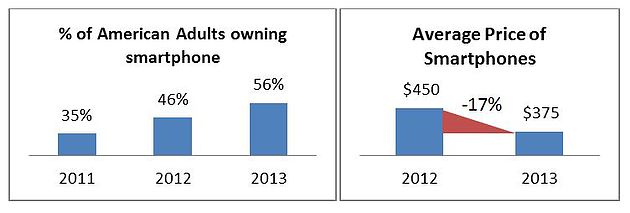PROGRESSIVE GROCER: The Disruptive Mobile Revolution

Cynthia Keating and Nick Crnkovich
What just happened? During every revolution there is a moment in time when you reach the point of no return. As marketers look to reach consumers and affect their shopping behavior in an increasingly targeted way, that time is now, as mobile technology has exploded on the scene.
Smartphones and tablets have now reached critical mass to fundamentally impact shoppers’ behavior.
According to findings from the Pew Research Center and The Nielsen Company, in 2006, only 3 percent of American adults owned a smartphone. By May of 2011, 35 percent of adults owned a smartphone, and in May of this year, that number increased to 56 percent. The demand is being accelerated by price competition, which has driven the average price of a smartphone down nearly 20 percent in the past year.
Tablet computers are experiencing the same kind of growth. The first-generation tablets were released in 2010. It is projected that tablets will surpass Total Portable and Desktop PCs as soon as 2015, according to IDC estimates. Bottom line: Americans are living and shopping in a mobile world.
The Medium for Millennials
Smartphones and tablets are a remarkably disruptive force in the shopping environment, particularly with hard-to-reach Millennials. Mobile devices are a vehicle for digitally delivered promotions, social media communication and apps providing tools to make shopping easier. They are a particularly effective tool to target Millennials, 80 percent of whom own a smartphone, according to Pew Research Center’s Tracking Survey, and which by the way have now passed Boomers as the largest cohort.
To effectively develop and execute mobile marketing, three principles should be established:
Integrate mobile marketing to achieve your strategic vision — not the other way around
Leverage the ability of mobile to disrupt the path to purchase
Keep the message simple
Integration with your strategy
This rapidly growing and disruptive technology is changing the way people, especially young people, shop. It is not, however, a strategy in itself. Define the strategy you have for your business and your brand, and use mobile as a way to execute. Is there a defined shopper segment that you are targeting for growth? Are there mega-trends such as health and wellness or convenience that you are leveraging to drive penetration of your products? Mobile is an ideal tool.
Integrating mobile efforts into your overall plan also helps ensure a consistent message, reinforcing your image and what you stand for with the shopper and the consumer. Axe is a great example of a brand leveraging a fully integrated strategy with consistent communication across all executional elements. One piece of this is the irreverent, male-focused attitude that is consistently communicated in traditional media, on its website, in its mobile app and on in-store fixtures. This integrated cross-platform execution fits well with the brand’s single-minded focus on appealing to a narrow, highly defined target.
Mobile is impacting organization strategy as well. A new position, director of vertical media integration ensures that a disciplined approach, consistent with your strategy, will be executed across vehicles. It requires a special skill set and full understanding of the various media in order to be able to coordinate how the message is integrated into the numerous communication vehicles.
Disrupt the Path to Purchase
One of the most exciting aspects of mobile marketing is that you can reach consumers and shoppers anytime and anywhere. Successful companies are experimenting with tactics that can draw shoppers into retailers or stimulate purchases in store. Partnering with retailers to accomplish your brand strategies by activating shoppers in their stores is a great way to get started. Retailers like Ahold tie promotions into their shopping apps while others, like Walgreens, provide functionality on its in-store map apps to drive purchase.
As long as these programs fit your strategy of targeting certain shoppers and driving specific behavior, it is worthwhile testing these new approaches to learn what works and what doesn’t.
Keep it Simple
CPG companies that succeed in mobile focus on keeping the message and the content of promotions and ads simple. Whether on a phone or a tablet, screens on mobile devices are small, requiring clear and direct content.
Research supports this assertion. Simplicity and performance are paramount in maintaining the interest of the consumer. When visiting a mobile site, 74 percent of consumers will wait five seconds for the site to load before abandoning the page, according to Gomez, and 46 percent are unlikely to come back if the mobile site did not work properly the first time. And what happens when a potential customer visits a mobile unfriendly site? Sixty-one percent of them are likely to leave for a competitor, says Karim Temsamani, head of the Asia-Pacific Region at Google Inc. There is a clear opportunity cost being sacrificed by organizations unwilling to go the extra mile to simplify their message.
With a roadmap of integration, disruption and simplicity, CPG companies must jump into the world of mobile quickly to take advantage of this technology. Unlike processes that take months or even years to develop, the mobile marketplace is rapidly evolving. Companies that choose a go-slow approach run the risk of being disintermediated by forces that they don’t understand or worse, being outflanked by more nimble competitors.
